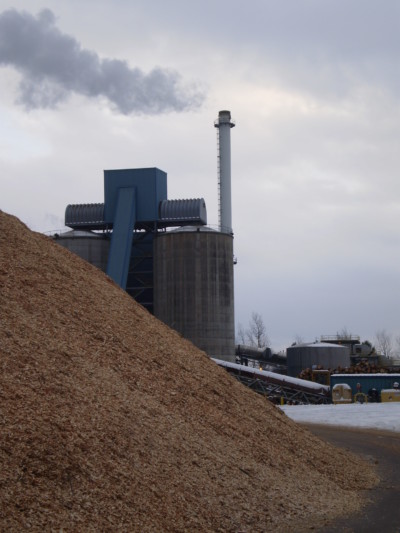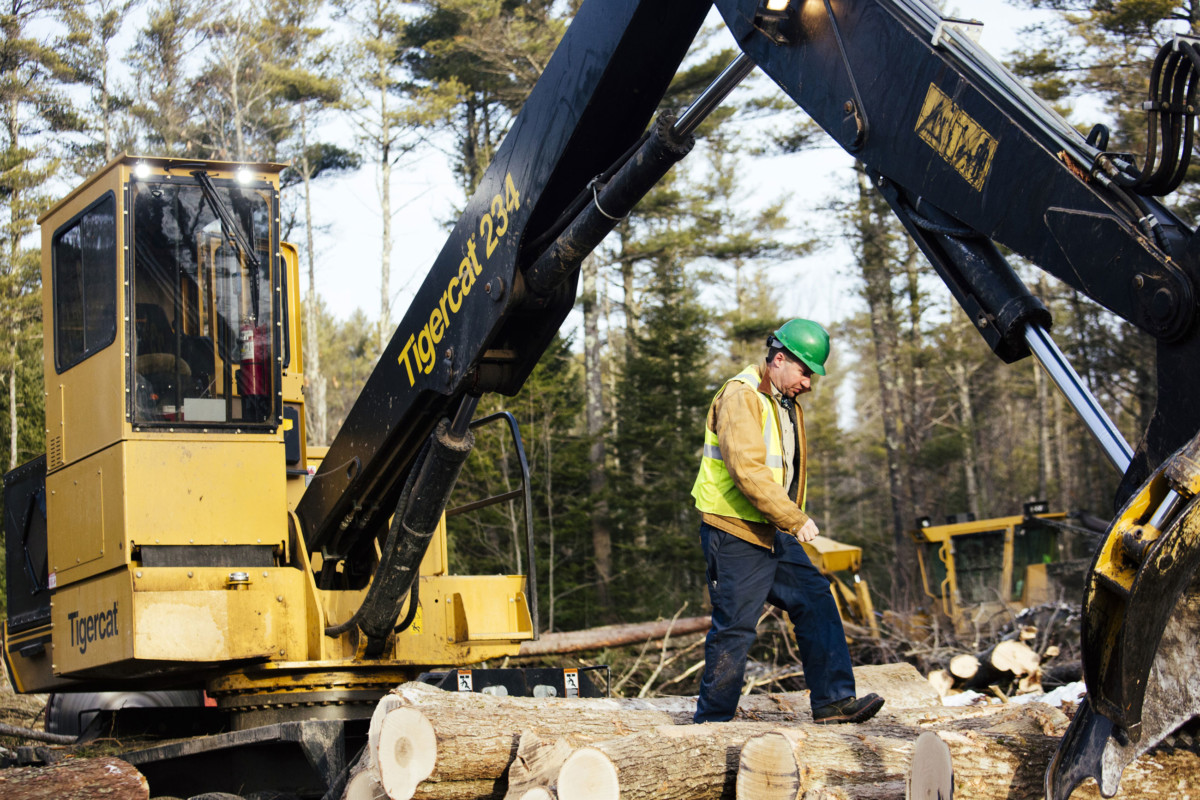A first-of-its-kind, peer-reviewed study documenting the increased respiratory diseases and other health problems experienced by people living and working near biomass power facilities was recently released by researchers in Germany, even as the US Environmental Protection Agency (EPA) has declared biomass energy to be “carbon neutral.” The EPA’s declaration may open the door to an unprecedented expansion of the controversial energy source, which includes burning trees and logging residue for electricity.
The study, titled “The Use of Biomass for Electricity Generation: A Scoping Review of Health Effects on Humans in Residential and Occupational Settings“ by Alice Freiberg et al., from Technische Universität Dresden in Germany, was “the first comprehensive scientific overview” of the health impacts of biomass power facilities on residents and workers. The most noteworthy finding was that European biomass workers have been exposed to sometimes high levels of gases and heavy metals linked to lung disease, cancer and central nervous system disorders.
Meanwhile, in response to the statement of policy released in April by former EPA Administrator Scott Pruitt, which stated the EPA’s intention to “treat biogenic CO2 emissions resulting from the combustion of biomass … as carbon neutral,” the biomass industry is looking to ramp up business.
Donna Harman, president and CEO of the American Forest & Paper Association, a trade group that represents pulp and paper companies nationwide, told Truthout that the EPA declaration — which effectively serves as a promise that the federal agency will continue to ignore the carbon dioxide released into the atmosphere from cutting and burning trees for electricity and/or heat — has emboldened her industry to “invest in efficient technologies to produce bioenergy.”
William Moomaw, emeritus professor of international environmental policy at the Fletcher School at Tufts University and the coordinating lead author of the 2001 Intergovernmental Panel on Climate Change chapter on greenhouse gas emissions reduction, told Truthout he fears the EPA’s declaration will result in more industrial-scale biomass electricity and heat in the US, which will only exacerbate climate change by degrading carbon-sequestering forests. “It’s a pure political decision which has serious global consequences,” Moomaw told Truthout via email.
Moomaw isn’t the only one with concerns. In 2016, 65 scientists sent a letter to Congress warning that “burning any carbon containing substance whether biomass or fossil fuels releases carbon dioxide into the atmosphere,” and that it can take anywhere from decades to a century for new tree growth to re-sequester greenhouse gases emitted from the generation of biomass energy.
Air Emissions
While climate impacts are at the forefront of the pushback against the EPA’s decision, the resulting increase in air emissions is also on the radar of some environmentalists.
“Noticeably lacking in this public debate over carbon accounting and whether biomass is carbon neutral is the discussion about public health impacts,” said Chris Ahlers, a staff attorney with the Philadelphia-based Clean Air Council, via telephone. Of course, climate change itself can indirectly impact human health through extreme temperatures, flooding, disease migration and other severe environmental alterations.
Even though biomass power facilities in the US employ filtration technologies to reduce emissions, burning biomass still emits air pollutants including particulate matter, volatile organic compounds and nitrogen oxides, which have been linked to health effects such as asthma and cancer by EPA, Centers for Disease Control and various public health organizations.
In 2016, Ahlers published an article in the journal Environmental Law, discussing the health impacts of two byproducts of biomass burning: particulate matter and nitrogen oxides.
Ahlers cited EPA findings of a link between particulates and mortality and nitrogen oxides and short-term respiratory effects.
Moreover, Ahlers pointed out how nitrogen oxides react with volatile organic compounds — also released through biomass combustion—to create ozone, stating, “EPA has not identified a threshold below which there are no adverse effects on human health from fine particulates and ozone.”
Effects of Biomass Power Facilities on Residents’ and Workers’ Health
In 2017 in the US, bioenergy (which includes everything from corn ethanol to biomass power and trash incineration, to residential wood heating) made up 45 percent of “renewable” energy, with electricity generation from 188 wood-burning biomass power facilities generating 5 percent of bioenergy.

While several studies have been conducted on the health impacts of using biomass fuel for cooking (mostly in developing nations), there have been relatively few focused on the health risks of biomass power facilities until now.
The Dresden study brought together the findings of nine studies (eight peer-reviewed) from UK, Denmark, Finland, Sweden, Germany and Thailand, with six focusing on risks to workers and two to nearby residents.
In the first of the two residential studies, the Thailand study zeroed in on residents living near two small biomass power facilities and found that they had a greater risk of respiratory diseases such as asthma and chronic obstructive pulmonary disease, allergies, and other symptoms such as itching and rashes, eye irritation, coughing, stuffy nose, sore throat and difficulty breathing.
The second residential study revolved around a Swedish biofuel power facility and identified “odorous air pollution” from smoke and dust and wood oils that were linked to symptoms such as fatigue, headaches, nausea, dizziness, eye and nose irritation, and coughing.
Interestingly, the symptoms correlated to residents’ perceptions of the pollution, with those who found it troubling being more likely to suffer from symptoms.
The remaining seven studies dealt with occupation hazards of biomass power facilities.
A Denmark study concluded that workers’ exposure to “endotoxins”—parts of bacteria cell walls found in organic material—was “statistically significantly associated with chronic bronchitis and wheezing.”
Another study conducted at the same facility also found respiratory symptoms to not only be the result of exposure to endotoxins, but fungi in the biomass as well.
Finnish scientists took a look at health impacts to workers from exposure to metals and gases from maintenance and ash removal in their nation’s biomass facilities, particularly the effects of combinations of metals or gases.
In terms of metals, the combined effects of arsenic, beryllium, cadmium and lead were linked to cancer; manganese, lead and selenium to central nervous system disorders; beryllium, cadmium, manganese and selenium to lower respiratory tract irritation; and aluminum, arsenic and selenium to upper respiratory tract irritation.
For gases, the combined effects of carbon monoxide and hydrogen were linked to central nervous system disorders while sulfur dioxide, nitric oxide, nitrogen dioxide, ammonia and hydrogen were linked to upper respiratory tract irritation.
The study also uncovered that workers were exposed to levels of aluminum, manganese and lead that were “high and partly exceeded Finnish occupational exposure limits.”
The individual metals were also thought to cause health impacts, according to the study. For instance, long-term exposure to high concentrations of aluminum can lead to scarring of the lungs and wreak havoc with the central nervous system; manganese can cause pneumonia and a disorder similar to Parkinson’s; and lead can stymie the formation of red and white blood cells and “induce neurotoxic effects” such as central nervous system or muscle disorders.
“This study shows that more safety equipment may be needed for employees of biomass plants,” says Tim Echols, vice chairman of the Georgia Public Service Commission, a strong proponent of an expansion of biomass energy in his state and the US. “Additional information on existing standards would have been helpful to determine the best course forward for biomass companies seeking to protect their employees.”
A UK study tallied 97 deaths worldwide within the biomass industry, while another analysis estimated the death rate to be the fourth-highest among all forms of energy.
Overall, the Dresden study determined that health impacts to biomass workers is “comparable with the fossil fuel industry.”
While the study didn’t analyze the health impacts from biomass processing, it briefly mentioned how earlier phases of producing and storing biomass may have some negative effects on workers. These ranged from the dangers involved with working in forestry and agriculture growing and extracting biomass; exposure to “risky substances” such as carcinogens, gases and heavy metals during thermal processing; and the risk of explosion, fire and local air pollution in the storage of biomass.
Further, workers who clean and/or repair facilities or handle ash are at risk, especially from dust, where exposure to endotoxins, bacteria, fungi and particulate matter “seemed to be high.”
When contacted for comment on the results of the study, Evan Dell’Olio, director of external and regulatory affairs for Roberts Energy Renewables, a developer and operator of biomass energy facilities based in Massachusetts, acknowledged that companies like his “should familiarize themselves with reports of this nature to advance their employee safety guidelines” but also expressed displeasure at what he described as the “simplified manner” in which the study suggests that fossil fuel energy facilities are akin to biomass facilities “simply because there are emissions involved.”
The Need for Additional Studies on Effects of Biomass Energy
The authors of the Dresden study have called for additional studies in which human exposure to various substances can be measured at facilities and then compared to levels that may harm health. If these raise red flags, observational studies would be the next step.
Unfortunately, lead author Alice Freiberg told Truthout she’s not optimistic there will be many more studies due to a lack of public demand. In particular, she cites a lack of “strong community resistance against bioenergy plants, pointing out that most biomass facilities are located in agricultural areas with sparse populations that are already used to significant odors and air pollution.
Yet, if the EPA’s decision to declare biomass energy carbon neutral results in a proliferation of new biomass facilities in the US, public concern may intensify, which may spur additional studies.
Of course, some biomass opponents believe we already have enough information on the subject to take action to protect public health.
“More studies aren’t needed to know what is already available from emissions data from biomass incinerators,” says Mike Ewall, executive director of Energy Justice Network, a national organization supporting local opposition to biomass and waste incineration. “Such data, reported to EPA databases, shows that biomass burning, to produce the same amount of energy, releases comparable amounts of key pollutants as burning bituminous coal.”
We have 9 days to raise $50,000 — we’re counting on your support!
For those who care about justice, liberation and even the very survival of our species, we must remember our power to take action.
We won’t pretend it’s the only thing you can or should do, but one small step is to pitch in to support Truthout — as one of the last remaining truly independent, nonprofit, reader-funded news platforms, your gift will help keep the facts flowing freely.
